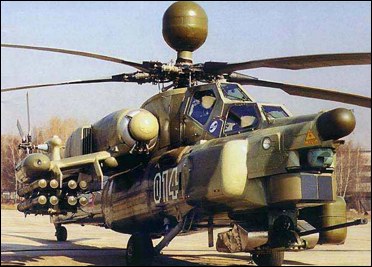
| Mil Mi-28N 1982 |  |
 |

| Mil Mi-28N 1982 |  |
 |
|
The "Night Havoc" helicopter first flew in November 1996 and the test procedures are scheduled for completion during 1999. The Night Havoc helicopter retains most of the structural design of the Mi-28. The main difference is the installation of an integrated electronic combat system. Other modifications include the main gearbox for transmitting higher power to the rotor; new design of high efficiency blades with swept- shaped tips; an engine fuel injection control system for high power operating modes. The main sensors of the integrated electronic combat system are the microwave radar antenna mounted above the rotor head and a FLIR (forward looking infrared) system. The integrated combat system uses onboard processing to display the helicopter location on a moving map indicator, and to show the flight, systems and target information on liquid crystal displays. The crew are equipped with night vision goggles.
Added night/all-weather operating capability. Russian Army funding announced January 1994; demonstrator (014) modified from first Mi-28 prototype (012); first hover 14 November 1995; formal roll-out 16 August 1996; first flight 30 April 1997. Mast-mounted 360° scan millimetre wave Kinzhal V or Arbalet radar (pod soon enlarged in vertical plane); FLIR ball beneath missile-guidance nose radome and above new shuttered turret for optical/laser sensors, including Zenit low-light-level TV. EFIS cockpit. Armament of production version to include 9M114 Shturm (AT-6 'Spiral') or 9M120 Vikhr/Ataka (AT-12 'Swinger') ASMs and Igla (SA-16 'Gimlet') AAMs and R-73 AAMs. New composites rotor with sweptback blade tips added subsequently. Mi-28N introduced uprated VR-29 transmission and IKBO integrated flight/weapon aiming system, with automatic terrain-following and automatic target search, detection, identification and (in formations of Mi-28Ns) allocation; Ramenskoye Breo-28N mission control system. Second prototype Mi-28N due for completion in first quarter of 2003 and will undertake bulk of state testing, which expected to occupy minimum of three and maximum of five years, after which it is intended to begin quantity production for the Russian armed forces and export customers. Total of five trials Mi-28Ns to be built by Rostvertol; TV3-117VMA engines initially, but 1,839kW Klimov VK-2500s to be installed later. Second helicopter funded jointly by Rostvertol and Southwest Sberbank. Jane's All the World's Aircraft, 2004-2005
TYPE: Two-seat twin-turbine combat helicopter. PROGRAMME: Developed from the basic Mi-28 to add night/all-weather capability. Versions for naval amphibious assault support and air-to-air missions projected. Russian Army funding announced January 1994; demonstrator (O14) modified from first prototype; first hover 14 November 1995; first flight 30 April 1997. Unofficially named Night Hunter and Night Pirate. Versions projected for naval amphibious assault support and air-to-air support. Description as Mi-28, unless shown otherwise. DESIGN FEATURES: Longer main rotor blades with curved tips; new VR-29 transmission main gearbox; multiwindow chin fairing in place of nose sensor turret. POWER PLANT: Two Klimov TV3-117VMA turboshafts, each rated at 1,863kW. AVIONICS: IKBO integrated flight/weapons system, comprising optical/Low-Light Television (LLTV)/Forward-Looking Infra-Red (FLIR) aiming unit for the weapons operator; mast-mounted 360° millimetric-wave Phazotron Arbalet; Kinzhal-V radar system; laser range-finder; pilot's FLIR for night operation; helmet-mounted target indicator; night vision goggles; radio command guidance system for Shturm (AT-6 Spiral) anti-tank missiles; data presentation system with colour liquid crystal multifunction displays; inertial and GPS-type navigation subsystems. Vitebsk self-defence system, including Pastel radar warning unit, Mak infra-red, laser warning, Platan electronic jamming and UV-26 flare dispenser. ARMAMENT: 2A42 single-barrel 30mm cannon mounted on moving NPPU-28 post with 250 rounds in two boxes; rotation within ±110° horizontally and +10°/-43° vertically. Two pylons under each stub-wing, each with capacity of 480kg; typically 9M114 Shturm (AT-6 Spiral) guided anti-tank missiles installed on two APU-8/4U launchers; up to eight Igla-V (SA-16 Gimlet) air-to-air missiles can also be carried; new type of short-range air-to-surface guided missile under development. Unguided weapons include free-fall bombs up to 500kg; KMGU submunition dispensers; UPK-23 and GUV pods with 80mm C-8, 130mm C-13 and 240mm C-24 rockets; and incendiary containers. Special containers for minelaying may also be fitted. Jane's Helicopter Markets and Systems
|